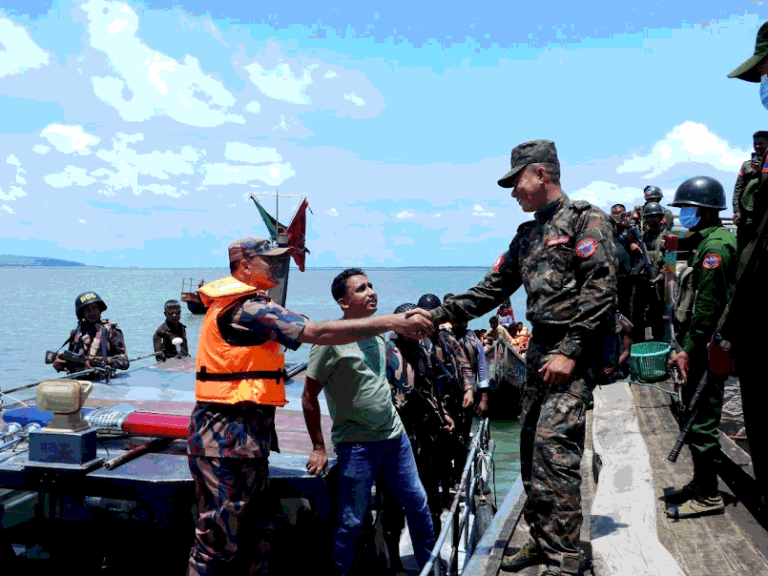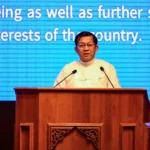
Territorial Control and Bangladesh–Myanmar Diplomatic Tensions
As the Arakan Army (AA) continues to control nearly all of Rakhine State and armed clashes stretch into neighboring regions of Ayeyarwady, Bago, and Magway, Bangladesh has begun to exhibit signs of direct engagement with the AA over issues at the shared border. In response, Myanmar’s military junta has lodged an official objection, protesting any interaction between Bangladesh and the AA.
Following this, Bangladesh’s caretaker government recalled both its ambassador to Myanmar and its military attaché to Dhaka. While Bangladeshi Prime Minister Muhammad Yunus stated that the ambassador’s return was merely for a regular diplomatic meeting, observers have interpreted the move as diplomatically symbolic.
It remains unclear whether Bangladesh sees the AA as a de facto authority in Rakhine and is engaging accordingly, or whether it is merely pursuing practical cooperation on border security matters. The ambiguity leaves questions unanswered. Bangladesh’s National Security Adviser recently acknowledged the caretaker government’s communication with the AA, which prompted Myanmar’s junta to formally object and summon the Bangladeshi ambassador.
Although these events occurred in late April and early May, they only came to public attention in late May. The developments also coincide with a broader context: a political rift between the Bangladeshi military and the caretaker government over policy towards the Rohingya refugee crisis. Prime Minister Yunus’s administration has shown diverging positions from the military establishment, particularly on how to handle the refugee issue and its broader implications.
Relations between Bangladesh and the Myanmar military have long been relatively cool and reserved—unlike Myanmar’s ties with other neighbors like India, China, and Thailand. During President Thein Sein’s tenure, a maritime boundary dispute was taken to international arbitration. Misunderstandings between the two nations have also persisted over the Rohingya issue.
Since the fall of Bangladesh’s Sheikh Hasina government, internal political shifts in Bangladesh have coincided with sweeping military losses in Rakhine by Myanmar’s junta. These parallel transformations have set the stage for a significant change in dynamics along the border.
With these developments, two diplomatic tracks now seem to be emerging: one between Bangladesh and Myanmar’s junta, and the other between Bangladesh and the AA. Bangladesh may now view the AA as a more stable and militarily dominant actor in Rakhine, especially since the junta appears incapable of recapturing major towns or territory there in the near term.
If the junta is unable to reassert control in Rakhine, Bangladesh may feel compelled to engage directly with the AA, considering it a more practical actor for safeguarding its own national interests. This line of thinking may underlie the Yunus government’s rationale.
Even the United Wa State Army (UWSA)—which enjoys de facto autonomy—does not usually see such open diplomatic gestures from neighboring countries. So, the junta’s increasing irritation and formal objections to Bangladesh’s engagement with the AA reflect its alarm at being sidelined.
The junta, while lacking broad international recognition, still counts on backing from powerful countries like China and Russia. With such backing, it has grown increasingly assertive in its diplomatic posture toward smaller neighboring states like Bangladesh.
Thank you for reading! Visit us anytime at Myanmar.com for more insights and updates about Myanmar
Related posts:
 Policy Dilemmas and Stability: Bangladesh’s Approach to the Arakan Army
Policy Dilemmas and Stability: Bangladesh’s Approach to the Arakan Army
 More than 200 killed in at least 243 military strikes across Myanmar since the earthquake.
More than 200 killed in at least 243 military strikes across Myanmar since the earthquake.
 FROM CONFLICT TO COMMERCE: REBUILDING MYANMAR’S ECONOMY
FROM CONFLICT TO COMMERCE: REBUILDING MYANMAR’S ECONOMY
 Myanmar Junta Admits Polls Can’t Cover Entire Country
Myanmar Junta Admits Polls Can’t Cover Entire Country
 RUSSIA, MYANMAR SIGN AGREEMENT ON PROMOTION, PROTECTION OF INVESTMENT
RUSSIA, MYANMAR SIGN AGREEMENT ON PROMOTION, PROTECTION OF INVESTMENT
 Scam Factories on the Thai–Myanmar Border: How Chinese Mafia Networks Operate
Scam Factories on the Thai–Myanmar Border: How Chinese Mafia Networks Operate
